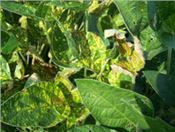Symptoms Of Sudden Death Syndrome Of Soybean Appearing

Figure 1. Symptoms of sudden death syndrome on soybean
Photo: Carl. Bradley, UK
DR. CARL A. BRADLEY
PRINCETON, KEN.
Symptoms of sudden death syndrome (SDS) have been appearing over the last few weeks in some soybean fields in the state. These symptoms first appear as yellow blotches between the leaf veins, which will turn to interveinal chlorosis (yellowing between leaf veins while the veins remain green) and then interveinal necrosis (dead leaf tissue between the veins while the veins remain green, Figure 1). Although symptoms are observed on the leaves, the fungal pathogen that causes SDS in Kentucky (Fusarium virguliforme) actually infects through the roots and never makes it to above-ground plant parts. The leaf symptoms observed are caused by a toxin produced by the fungus that moves up through the plant and accumulates in the leaves.
Management
No effective “in-season” management tactics are available for control of SDS. The primary way to manage SDS is to choose a soybean variety with a high level of resistance to SDS. In addition, two seed treatments that have been extensively tested by university plant pathologists that have been shown to provide good efficacy against SDS are ILEVO (BASF) and Saltro (Syngenta). Although these seed treatments are very effective, some symptoms of SDS may still appear on very susceptible varieties even if one of these seed treatments was used.
Symptoms of SDS may be more severe in fields with high populations of soybean cyst nematode. In addition, soybeans planted early in the spring (March/April) may be more at risk to infection by the SDS pathogen because of the cooler soil temperatures that may occur that time of the year.
‘Look-a-like’ Disease
Another disease that can be observed in Kentucky that causes similar foliar symptoms is southern stem canker. As the name of this disease suggests, dark lesions/cankers will occur on the outside of soybean stems affected by southern stem canker, in addition to interveinal chlorosis/necrosis on the leaves. Management of southern stem canker differs from management of SDS, so it is important to distinguish between these two diseases. Short videos on both of these diseases are available as part of the UK – Kentucky Agricultural Training School (KATS) online here. ∆
DR. CARL A. BRADLEY: Plant Pathology Extension Specialist, University of Kentucky